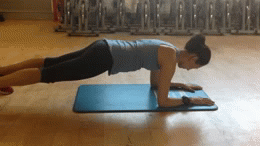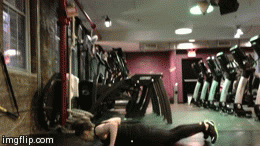In the female dominated world of yoga, I’m actually seeing more men attending my yoga classes. Although the classes I teach are more of a power yoga style, they’re still coming week after week and I love it. It shows me that the old association of yoga being touchy feely, only for women and for hippies is finally making its breakthrough. Men are understanding the importance of adding yoga and stretch to their fitness routine and those who are consistent are seeing results.
With my experience in teaching yoga and performing personalized stretch sessions, it’s evident that yoga and stretch are great for the body and can increase potential in very specific activities. Here are some examples!
Mike Loves Yoga & Stretch
My good friend and trainer, Mike plays football and in order for him to be faster and more agile on the field, he needs to move in different planes of motion at max speed. If his hip flexors and rotators are tight, his ability of moving quickly and easily is limited to a very specific range. He can lack power in agility or move too quickly when tight which can cause an injury. Mike stretches with me once a week in addition to taking yoga classes. Great job, Mike!
Manuel Loves Yoga & Stretch
My man loves his overhead squats! This CrossFit exercise requires specific muscle mechanics in order to execute safely and properly. So much mobility, flexibility, and stability is required in the shoulders, hips, hamstrings, glutes and adductors. Without a full range of motion or flexibility in those muscles, this exercise becomes increasingly difficult and unsafe to perform. Manuel spends at least 15 minutes after his workout to stretch, takes my power yoga class, and will grudgingly take a class with me. Yay Manuel!
Jonathan Loves Yoga & Stretch
Jonathan owns a finance company and barks orders all day long to over 100+ employees. He is consistently in demand and pulled in every direction. The stress and tension he feels every day is unbearable at times and the only way he can wake up the next morning to handle the pressure all over again is to create space in his body and mind. But that doesn’t come without challenge. In our stretch sessions, he is forced to succumb to specific yoga poses, stretches, and breathing that help release physical and mental tension. Without this, he would not perform at the peak level his work demands of him. Way to go, Jon!
There you are…solid proof that yoga does a man’s body good.
Here are 4 poses/stretches that all men can benefit from. So whether you perform agility sprints, deep squat, or run a successful company, these are the go-to stretches that will change your life!
LOW LUNGE (ANJANEYASANA)

Low Lunge
Benefits:
1. Stretches hip flexors (illiopsoas, rectus femoris, sartorius) and rear of the hips (piriformis and glutes)
2. Strengthens quadriceps of the front leg, helping to support and increase stability in the knee
3. Promotes balance and mental focus
Make sure to:
– Align your front knee above the ankle
– Drop your hips down, engage your abdominals to protect the lower back, and lift the chest up
DOUBLE PIGEON (AGNISTAMBHASANA)

Double Pigeon
Benefits:
1. Stretches outer hips (gluteal group, tensor fasciae latae) and lateral rotators (piriformis, quadratus femoris, gemellus, obturators, psoas, sartorious)
2. Increases range of motion at the hips
3. Therapeutic for stress relief and anxiety
Make sure to:
– Sit as far forward as you can on your sit bones or in front of your tailbone.
– Align your foot directly on the knee and bottom foot directly below the knee.
– Flex both feet to protect and stabilize the knee joint
DOLPHIN POSE (MAKARASANA)

Dolphin Pose
Benefits:
1. Opens upper back, shoulders, hamstrings, calves, and feet
2. Strengthens core, arms, and legs
3. Calms the brain and helps to relieve stress and tension
4. Great prep pose for forearm stand inversion
5. Relieves headache, back aches, and fatigue
Make sure to:
– Keep the legs as straight as you can and press the heels down to the floor
– Keep a neutral pelvis and slight arch in the lower back
– Press firmly into the forearms to stabilize shoulders and upper back
– Draw shoulders blades down to relax the trapezius from overworking
RECLINED SPINAL TWIST (SUPTA MATSYENDRASANA)

Reclined Spinal Twist
Benefits:
1. Stretches mid to lower back muscles, pectorals (chest), shoulders, hips and glutes.
2. Stimulates and detoxifies the organs
3. Lengthens, relaxes, and realigns the spine
4. Encourages blood flow and aids with the health and function of your digestive system
Make sure to:
– Adjust your hips to align with your spine before dropping your knee to twist. For ex: if you drop your left knee to the right, move your hips slightly to the left before doing so.
– Relax your neck and try to connect both shoulders to the floor
– Breathe deeply when you twist
There are so many more stretches and yoga poses that are beneficial but these are perfect to do when limited on time. They target the hips, shoulders, lower back and chest – the most commonly tight areas in men. Women can absolutely benefit from these stretches, too. All stretches are great as long your body is set up properly and they’re performed safely.
Yes…yoga and stretching can be boring, monotonous, time consuming, and painful. But we work so hard all day to compound, contract, and tighten our muscles with daily activity, workouts, and simply living life. Take the time to create space, lengthen, and reverse those effects so you can move freely and never feel limited in the potential of your body! Spend some time stretching after your workouts, take a yoga class or learn more about my Stretch Sessions. Now…Go Stretch!






















